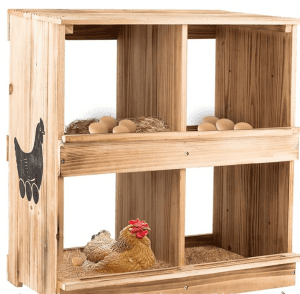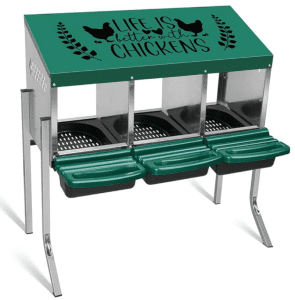Chicken Nesting Boxes
Chicken Nesting Boxes
Introduction to Chicken Nesting Boxes
There’s something uniquely satisfying about raising chickens. Whether it’s the joy of watching them peck around the yard or the pleasure of collecting fresh eggs, chicken keeping is a rewarding experience. An essential aspect of this journey comfortable and safe chicken nesting boxes. Not just any space will do; these boxes are pivotal for the well-being of your chickens and the quality of the eggs they produce.
Importance of Nesting Boxes
Why are nesting boxes so crucial, you might wonder? For starters, they provide a secure and serene environment for hens to lay their eggs. Without a proper nesting area, hens might lay their eggs in random locations, making them hard to find and more susceptible to damage or predation. Nesting boxes also help in keeping the eggs clean and in one piece.
Benefits for Chickens and Owners
For the chickens, a well-designed nesting box means comfort and privacy, essential factors for a stress-free laying process. For owners, it means ease of egg collection and management of the living space. Moreover, well-constructed nesting boxes can prevent egg-eating habits and deter predators.
Choosing the Right Materials
The choice of materials for your nesting boxes is not just a matter of aesthetics; it’s about functionality and safety.
Natural vs. Synthetic Materials
Natural materials like wood are popular for their insulation properties and traditional appearance. However, synthetic options like plastic can be more durable and easier to clean. Consider the climate and location of your coop when deciding.
Durability and Maintenance
Whichever material you choose, durability should be a top priority. A sturdy nesting box withstands the elements and the pecking and scratching of your hens. Maintenance is another factor; some materials require more upkeep than others.
Ideal Dimensions and Design
 Creating the perfect nesting box starts with understanding the ideal dimensions and design features that cater to your chickens’ needs.
Creating the perfect nesting box starts with understanding the ideal dimensions and design features that cater to your chickens’ needs.
Size Considerations
Each nesting box should be spacious enough for a hen to turn around comfortably, but cozy enough to feel secure. Generally, a size of 12x12x12 inches works well for most breeds. If you have larger breeds, you might need to adjust the dimensions accordingly.
Design Features for Comfort
A slightly elevated front lip can help keep bedding and eggs in place, while a slanted roof discourages roosting on top of the boxes. The interior should be free from sharp edges or protrusions to prevent injury.
Accessibility for Chickens
Accessibility is key. The boxes should be easy for the hens to enter and exit, but not so low that pests can easily invade. A good rule of thumb is to place them at least a few inches off the ground.
Location and Placement of Nesting Boxes
Where you place your nesting boxes in the coop can significantly influence how well they’re used by your hens.
Best Places in the Coop
Nesting boxes should be placed in a quieter, more secluded part of the coop, away from the feeding and watering areas. This separation helps the hens feel secure and undisturbed while laying.
Height and Accessibility
While some elevation is beneficial, too high can deter hens from using them. A height of 2-3 feet off the ground is typically ideal. If you have varying breeds, consider multiple levels of nesting boxes to cater to all your chickens.
Ensuring Comfort and Safety
Your chickens’ comfort and safety in their nesting boxes are paramount for their well-being and productivity.
Bedding Materials
Soft, absorbent materials like straw, pine shavings, rice hulls or hay make excellent bedding in nesting boxes. They provide comfort, keep the eggs clean, and are relatively easy to replace during cleaning.
Protecting from Predators
The design of your nesting boxes should also take into account the protection from predators. Ensure that the boxes are secure and not easily accessible to any potential threats from outside the coop.
 Maintenance and Cleaning
Maintenance and Cleaning
Keeping nesting boxes clean is crucial for the health of your chickens and the quality of their eggs.
Regular Cleaning Schedule
Establish a regular cleaning schedule. Remove soiled bedding, wipe down surfaces, and replace with fresh bedding regularly. This not only keeps the boxes hygienic but also encourages the chickens to continue using them.
Preventing Parasites and Diseases
A clean nesting box is your first defense against parasites and diseases. By maintaining cleanliness, you minimize the risk of issues like mites, lice, and bacterial infections.
Encouraging Hens to Use the Nesting Boxes
Even with the perfect setup, sometimes hens need a little encouragement to use their new nesting boxes. Turn your nesting box in to a tranquil and mite free haven by adding lavender and oregano to their bedding.
Training Your Chickens
Place fake eggs or golf balls in the nesting boxes to mimic eggs. This often encourages hens to lay in the boxes. Also, ensure the boxes are accessible from the time the hens are young so they become accustomed to them. I always do this but what I have found is the hens throw the fake eggs out of the nesting box, as if to say, you don’t belong here I’ve decided to lay my eggs here.
Chickens can exhibit quirky, sometimes amusing behaviors, especially when it comes to laying eggs. Despite having multiple nesting boxes, they often fixate on one, leading to a comical yet chaotic scene. It’s not uncommon to witness a group of hens impatiently waiting, often vocally expressing their urgency, for one to vacate the favored nesting spot. In more peculiar instances, you might even find chickens piling on top of one another in a single box, all vying for the same space to lay their eggs. This amusing spectacle highlights the unique, sometimes baffling, social dynamics of chickens, reflecting their instinctual preferences and quirky personalities.
Adjustments and Troubleshooting
If your hens are reluctant to use the boxes, observe their behavior to identify potential issues. It could be due to the location, height, or something inside the boxes that they dislike. Be prepared to make necessary adjustments. When ever available I would throw some lavender twigs and flower petals into the nesting boxes because in the wild you will often find chicken line their boxes with flowers.
DIY vs. Store-Bought Nesting Boxes
When it comes to nesting boxes, you have the option to build your own or purchase pre-made ones.
Pros and Cons
DIY boxes allow for customization but require time and skills. Store-bought boxes, on the other hand, are convenient and often come with optimized designs, but they can be more expensive and less customizable.
Tips for DIY Enthusiasts
If you opt for DIY, ensure you use safe and non-toxic materials. Follow guidelines for dimensions and comfort, and don’t hesitate to get creative while keeping the chickens’ needs in mind.
Additional Features to Consider
There are additional features that can enhance the functionality of your nesting boxes.
Ventilation
Good ventilation is important, especially in warmer climates. Ensure that there’s enough air circulation to keep the nesting area comfortable and dry.
Egg Collection Accessibility
Design the boxes in a way that makes egg collection easy. This could mean having a lid that opens from the top or a side access point.
Impact on Egg Production
The quality of the nesting environment has a direct impact on egg production.
Influence of Nesting Environment
A comfortable, safe, and clean nesting box encourages regular laying. Hens that are stressed or uncomfortable are less likely to lay consistently.
Observing Chicken Behavior
Pay attention to your chickens’ behavior. It can give you insights into how they perceive their nesting environment and whether any improvements are needed.
Addressing Common Challenges
Even with the perfect setup, there can be challenges.
Avoiding Egg Eating
If hens start eating their eggs, it could be due to lack of calcium, boredom, or discovery of a broken egg. Ensure they have a balanced diet and keep the nesting area clean and undisturbed.
Rollaway egg collection systems are a game-changer in the world of chicken keeping. Designed ingeniously, these systems feature a gently sloped floor inside the nesting box, encouraging eggs to ‘roll away’ into a protected compartment immediately after being laid. This ingenious design serves multiple purposes. Firstly, it dramatically reduces egg breakage and ensures clean eggs, as they are quickly moved away from the hen, preventing pecking, eating, or accidental trampling. Secondly, it simplifies the egg collection process for the keeper. You no longer need to disturb the hens or reach into the nesting boxes; instead, eggs can be conveniently retrieved from the collection tray. This setup not only promotes better hygiene but also reduces the stress on both the chickens and the keeper. Moreover, rollaway systems are adaptable; they can be incorporated into DIY nesting boxes or found in ready-made options, catering to various flock sizes and coop designs. This system exemplifies how a simple, innovative approach can enhance efficiency and welfare in poultry management.
Dealing with Broody Hens
Broody hens may hog the nesting boxes. Providing a separate area for broody hens can help keep the nesting boxes free for others.
Seasonal Considerations
Nesting Boxes need to adapt to different seasons.
Adapting to Weather Changes
In summer, ensure the boxes are cool and ventilated. In winter, they should be insulated yet still have some ventilation to avoid moisture build-up.
Special Winter Design
Consider adding more bedding in winter for warmth and rotating the boxes if there are drafts or dampness issues.
Innovations in Nesting Box Design
The world of chicken keeping is ever-evolving, with new designs and innovations in nesting boxes.
Smart Nesting Solutions
From temperature-controlled boxes to automated egg collection systems, there are numerous innovations aimed at making chicken keeping more efficient and comfortable for both hens and owners.
Future Trends
Expect to see more sustainable materials, smart monitoring systems, and designs that cater to the welfare of the chickens in future nesting box designs.
Conclusion: Enhancing Your Chicken Keeping Experience
Investing time and effort in setting up the right nesting boxes can significantly enhance your chicken keeping experience. It’s not just about the eggs; it’s about creating a harmonious and healthy environment for your feathered friends.
FAQs about Chicken Nesting Boxes
1.What is the best material for chicken nesting boxes?
The best material depends on your climate and maintenance preference. Both natural materials like wood and synthetic options like plastic have their advantages.
2.How many nesting boxes do I need for my flock?
A general rule is to have one nesting box for every 3-4 hens.
3.Can I use household items as bedding in the nesting boxes?
It’s best to stick to materials like straw, pine shavings, or hay, as they are safe and comfortable for the chickens.
4.How do I stop my chickens from roosting on top of the nesting boxes?
A slanted roof design can deter chickens from roosting on top of the boxes.
5.Are there any specific designs that deter predators?
Designs with secure latches and elevated positioning can help deter predators.
Other Article You May Be Interested In
Bears and Chickens – How to avoid encounters




 Maintenance and Cleaning
Maintenance and Cleaning



